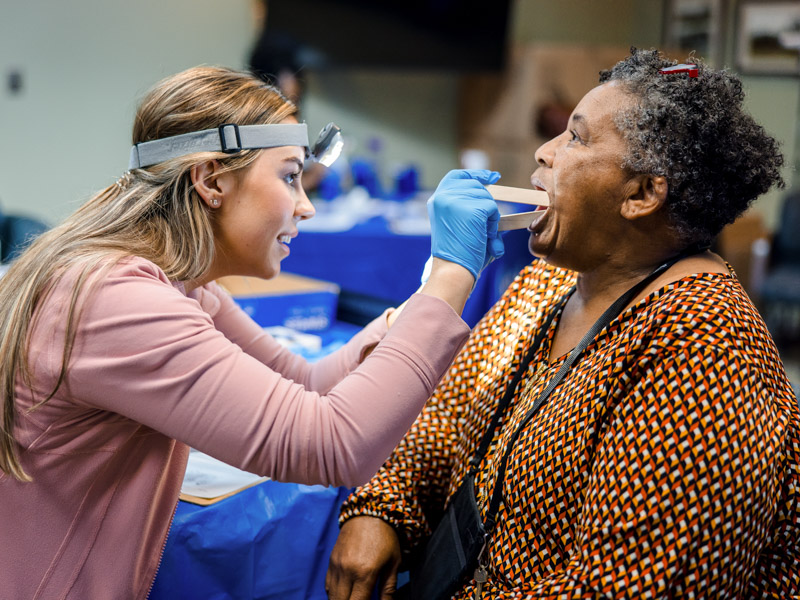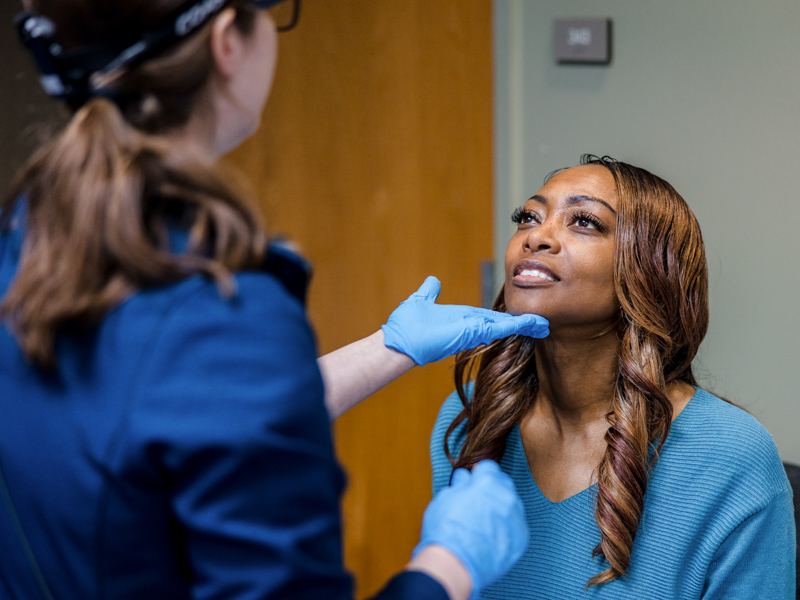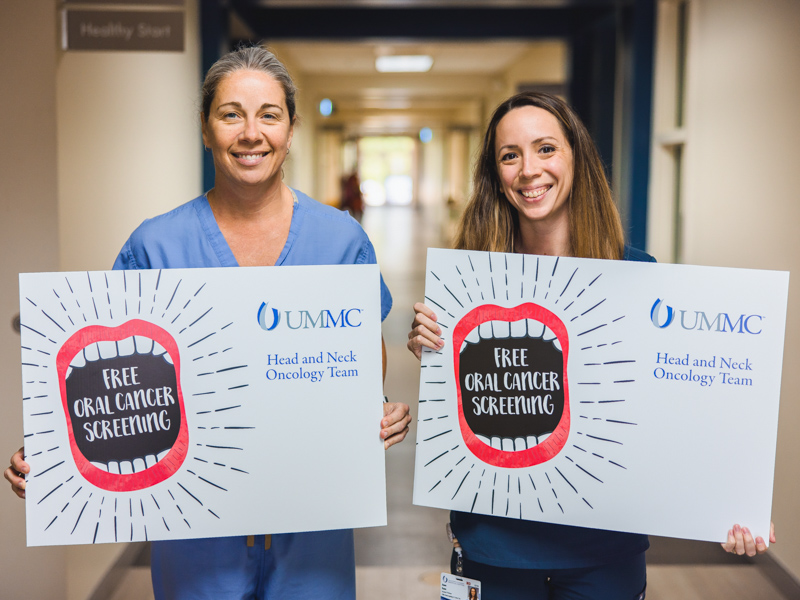By: Rachel Vanderford, UMMC Communications
Photos By: Lindsay McMurtray/ UMMC Communications

Dr. Amy Krecker, a resident in the Department of Otolaryngology-Head and Neck Surgery, checks the mouth of JoAnn Smith of Terry during the department’s 2023 free oral cancer screenings.
Oral cavity and oropharynx cancers—those that develop in the mouth, base of the tongue, tonsils and throat—are on the rise, especially in adults under 45 years old who have no history of risk factors such as tobacco or alcohol consumption.
“These are people who have never used tobacco and are not alcohol users,” said Dr. Gina Jefferson, head and neck surgical oncologist at the University of Mississippi Medical Center. “The rise of oral cavity cancer is primarily among young adults.”
Cancers of the oral cavity and oropharynx most commonly appear on the tongue, tonsils, soft tissues of the throat, gums and the floor of the mouth. They can also occur on the lips, roof of the mouth and minor salivary glands.
The American Cancer Society estimates that in 2025, about 59,660 new cases of oral cavity and oropharyngeal cancer will be diagnosed in the United States, causing more than 12,000 deaths. These cancers are more than twice as common in men as in women, likely due to higher rates of tobacco and alcohol use among men. The average age at diagnosis is 65, but over 20% of cases occur in people younger than 55.

Dr. Eleni Mijalis, a resident in the Department of Otolaryngology-Head and Neck Surgery, checks the chin and mouth of Kimberly Funchess of Flora during the department’s 2023 free oral cancer screenings.
Historically, smoking and drinking alcohol have been the biggest culprits behind these cancers. In fact, rates of oral cavity cancer declined in the 1990s as tobacco use dropped. This is not the case in Mississippi where tobacco use has not decreased in the same degree as nationwide. In addition, since the mid-2000s, those numbers are rising again—this time linked to a different cause: human papillomavirus, which involves the throat, or oropharynx–specifically, the tonsils and the base of tongue.
HPV is the most common sexually transmitted infection in the United States. About 10% of men and 3.6% of women have oral HPV. While most people clear the virus naturally, in some it persists and can lead to cancer years later. HPV is now thought to cause up to 70% of oropharyngeal cancers in the US.
“The human papillomavirus vaccine is effective at not only preventing throat cancer—it’s also effective at preventing cervical cancer and other cancers associated with HPV,” Jefferson said.
The CDC recommends two doses for children between the ages of 9 and 14. Those who begin the series after 15 require three doses in order to be fully protected.
The good news is that these cancers tend to respond better to treatment than those not related to HPV, especially when caught early. The key, Jefferson said, is early detection. And that often begins at the dentist.

Dr. Lana Jackson, left, professor in the Department of Otolaryngology-Head and Neck Surgery, and Dr. Anne Kane, an assistant professor in the department, were among caregivers staffing free oral cancer screenings in 2023.
“Unlike other cancers of your body where there are screening tests… there’s no specific test for head and neck or oral cavity or oropharyngeal throat cancer,” said Jefferson. “So, the traditional and best way to have a good screening for these cancers is with your dentist.”
The American Dental Association recommends a dental checkup every six months. Dentists and hygienists are often the first to notice abnormal lesions or ulcers that could be signs of early cancer.
Symptoms to watch for include non-healing sores in the mouth, sore throat, difficulty or pain while swallowing, coughing up blood, trouble managing saliva, a muffled voice or persistent one-sided ear pain.
“It’s abnormal for any adult over the age of 40 to have one-sided, constant ear pain,” Jefferson said. “That often reflects a nerve that’s being irritated by a mass that should not be there.”
Preventative steps include avoiding tobacco, limiting alcohol consumption and getting vaccinated against HPV.
“The best prevention for any cancer actually is no tobacco use,” she said.
When it comes to survival, timing matters. The sooner the diagnosis, the better the outcome. “Every time you visit the dentist, a professional should be screening you for oral cancer; dentists and dental hygienists are trained to notice the signs and symptoms and are also looking in your oral cavity regularly—hopefully every six months,” said Elizabeth Carr, director of the Mississippi Population Oral Health Collaborative and chair of the Department of Dental Hygiene.
“Early-stage cancer means it hasn’t spread elsewhere in the body, so those patients are going to have a better chance at five-year survival than someone who has had their cancer spread to a distant site from where it originated,” said Jefferson.
In the early stages, the survival rate at five years is going to be around 80% to 90%. Once cancer has spread from the mouth or throat to the lymph nodes in the neck, the rate of survival is between 50% and 70%. If the cancer has spread elsewhere in the body, that rate is around 20% or less.
“So, if you take people with early-stage and people with late-stage cancer, on average, it’s about 70% survival at five years,” she said.
To support early detection, the Department of Otolaryngology – Head and Neck Surgery is offering free oral cancer screenings Wednesday, April 16 from 8 a.m. to 3 p.m. at the Jackson Medical Mall.
The screening event is open to the public and will provide a quick, noninvasive exam to check for signs of cancer. The department has also partnered with Onyx Care, who will offer the HPV vaccine to those who are eligible. The ACT Center for Tobacco, Treatment, Education and Research will be available to discuss smoking cessation strategies and their free services. No appointments are needed.
For more information, email ent@umc.edu. To schedule an appointment with the UMMC Ear, Nose, Throat Clinic, call (601) 984-5160.


